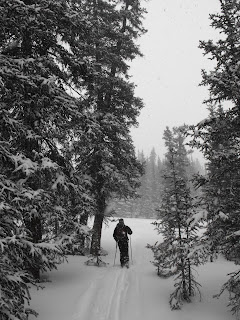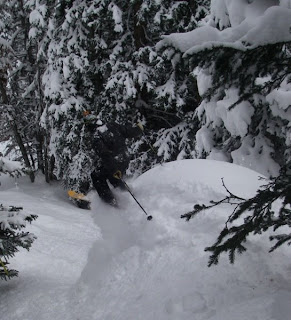 Setting safety from shore is a very important skill for kayakers, and is an area that I see many mistakes. Most people seem to think that if they know how to throw a rope, they also know how to set safety, and they tend to overlook the most important aspect: Where to stand! I can't begin to count the number of times someone I'm paddling with grabs their rope and stands right next to the hole on top of a flat rock (Tunnel Falls). I'll explain why that is a useless attempt at safety.
Setting safety from shore is a very important skill for kayakers, and is an area that I see many mistakes. Most people seem to think that if they know how to throw a rope, they also know how to set safety, and they tend to overlook the most important aspect: Where to stand! I can't begin to count the number of times someone I'm paddling with grabs their rope and stands right next to the hole on top of a flat rock (Tunnel Falls). I'll explain why that is a useless attempt at safety.So, how do we choose a good spot to set safety?
First, you need to choose which hazards are posing enough of an issue to need shore safety, and anticipate what will happen to a kayaker if they "encounter" the hazard.
Second, stand in a spot with the qickest access to the potential swimmer, and that allows the current to aide you in bringing them to shore. This may require more than one person in certain situations. If you set safety up in the right spot, the river should do most of the work.
Okay, now I have laid out the main concept, so let's discuss some specific situations. When your hazard is a pin rock or a strainer, you are probably anticipating that a swimmer could get stuck there with the possibility of flushing past the entrapment and floating downriver. In this scenario, it is best to have someone on the hazard in order to grab a swimmer quickly and pull them out. If you can't get on the hazard then you should be as close to it as possible and slightly upstream so you can communicate and get a rope to the swimmer quickly. Since there is also potential for the swimmer to flush past the entrapment, you will want someone setup further downstream as backup. This is often a kayaker staged in a downstream eddy, and could also be shore safety.
The next hazard I want to discuss is a true keeper hole. Setting safety for a keeper hole is much different than a violent flushy hole, which we'll discuss next. Since a keeper hole is going to recirculate a swimmer, we want to set safety close to the hole. Idealy, you will stand next to the hole and slightly downstream. If your friend is getting recirculated, get visual confirmation that they want the rope before you throw it. Once they grab it, you can pull them downstream towards you to safety. If it's a cauldron type walled- in keeper hole, get directly downstream of the hole if you can. That way you can always see the swimmer and you can throw the rope upstream into the pocket and haul them out using the current to your advantage.
The next situation is a more common type of hole. At least 95% of holes run by kayakers will flush someone once they wet exit, which makes setting safety for them much more dynamic than other hazards. That's because when the hole flushes them, the swimmer is moving quickly downriver until you pull them out or they swim to shore. This is the situation where I see the most mistakes in where people stand with their ropes. Let's go back to the first step: Identify the hazard and anticipate what will happen to a swimmer. In a violent flushy hole, a kayaker may surf for awhile before they swim. When they exit their boat what happens?: they get pushed to the bottom and downstream. Now remember step 2; set yourself up in a spot where you can get to the swimmer quickly AND use the current to your advantage. In order for the current to help you, obviously standing downstream of them is mandatory. Just how far downstream is the tough question. Let's use Tunnel Falls on Gore Canyon as an an example. Tunnel is a typical violent hole that will hold you for awhile if you stay in your kayak. As soon as you wet exit, you'll get pushed deep and pop up about 30-40 feet downstream. Now it's going to take you a second or two to get the water out of your eyes and look for the rope. In that second, you've probably moved another 20 feet downstream for a total of 60 feet or more beyond the hole. If your safety is set up on the river left rock 20 feet below the hole, do you think they even have a remote chance of roping you out? No. Even if they threw the rope down to you, you are going to pull them into the river immediately. I've seen it happen. If they thought ahead and set an anchor, you won't pull them in, you'll just get stuffed under water on the end of the rope until you are forced to let go and take your chances with the river. If your roper is standing where I normally stand on river right about 100 feet below the hole; they will be able to yell to you when you surface, throw the rope to you when you are still upstream of them, and let the river bring you right to them. The main idea is to stand far enough downstream that you can throw the rope to the swimmer while they are pretty far upstream of you. You should be standing in an eddy or on shore downstream of the eddy line. As the swimmer floats towards you, haul them in hand over hand so that they cross the eddy line just before they float past you. If they pass you, the force on the rope is going to increase dramatically as they get further downstream.

This is a sharp contradiction to the old pendelum method, where the roper stands above the eddy, hits the swimmer as they are floating past, and pendulums them into the eddy below. This works sometimes, but the trouble is that it only works with the perfect eddy line. Many times the swimmer stops as soon as they hit the eddy line. At this point there is a huge amount of force on each end of the rope. Someone is going to have to let go. This is also where I've seen many ropers pulled into the river. All of this can be avoided by using the current to bring the swimmer to you.
By no means have I covered every situation. Thee are plenty of times when it's impossible to get far enough downstream because of a cliff or another rapid. But if you do everything you can to set yourself up to use the current, you will increase your chances of pulling your friend out of the river unscathed.
Check out the Downstream Edge river rescue courses to learn and practice these techniques in realistc scenarios. We offer affordable courses designed for expert kayakers as well as beginners and intermediates. DSE rescue classes will make you a more confident and safer paddler, no matter what level of boater you are. We are also doing very inexpensive one-day clinics at paddlefest this year. Http://www.downstreamedge.com
--Nick Wigston

























 After every lap I tried to get a little big boat rodeo action in the final hole. I think I stuck a windowshade or two.
After every lap I tried to get a little big boat rodeo action in the final hole. I think I stuck a windowshade or two.